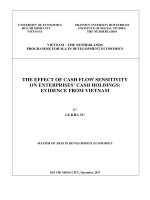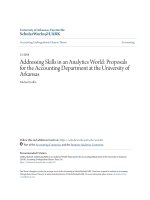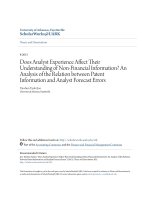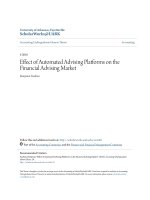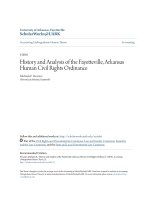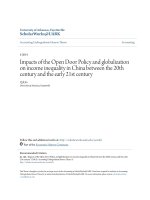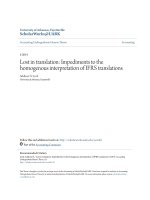Accounting undergraduate Honors theses:The effect of CEO IT expertise on the information environment - Evidence from management earnings forecasts
Bạn đang xem bản rút gọn của tài liệu. Xem và tải ngay bản đầy đủ của tài liệu tại đây (1.78 MB, 92 trang )
University of Arkansas, Fayetteville
ScholarWorks@UARK
Theses and Dissertations
8-2014
The Effect of CEO IT Expertise on the Information
Environment: Evidence from Management
Earnings Forecasts
Jacob Zachary Haislip
University of Arkansas, Fayetteville
Follow this and additional works at: />Part of the Accounting Commons, and the Management Information Systems Commons
Recommended Citation
Haislip, Jacob Zachary, "The Effect of CEO IT Expertise on the Information Environment: Evidence from Management Earnings
Forecasts" (2014). Theses and Dissertations. 2230.
/>
This Dissertation is brought to you for free and open access by ScholarWorks@UARK. It has been accepted for inclusion in Theses and Dissertations by
an authorized administrator of ScholarWorks@UARK. For more information, please contact ,
The Effect of CEO IT Expertise on the Information Environment:
Evidence from Management Earnings Forecasts
The Effect of CEO IT Expertise on the Information Environment:
Evidence from Management Earnings Forecasts
A dissertation submitted in partial fulfillment
of the requirements for the degree of
Doctor of Philosophy in Business Administration
By
Jacob Z. Haislip
Texas Tech University
Bachelor of Arts in Accounting, 2008
Texas Tech University
Master of Science in Accounting, 2008
August 2014
University of Arkansas
This dissertation is approved for recommendation to the Graduate Council.
_________________________________
Dr. Vernon J. Richardson
Dissertation Director
_________________________________
Dr. Gary F. Peters
Committee Member
_________________________________
Dr. Rajiv Sabherwal
Committee Member
ABSTRACT
Firms depend on information technology to provide high quality internal information, but
prior research suggests that IT is underutilized (Venkatesh and Bala 2008). Therefore, using a
sample of firms with equivalent levels of technology in their information systems, I investigate
whether firms that employ CEOs with IT expertise make forecasts that are more accurate. I
argue that CEOs with IT expertise are more likely to encourage the utilization of IT in making
earnings forecasts, thus increasing the accuracy of the forecasts. This argument is supported by
prior research that suggests that people are more likely to utilize technology if they have more
experience with IT (Venkatesh et al. 2012). This research suggests that executives with IT
experience are more likely to utilize IT because they perceive it as easy to use. Overall, I find
that CEOs with IT expertise make forecasts that are more accurate. In additional tests, I also
find that CEOs with IT expertise do not manage earnings to maintain accuracy. Finally, I find
that analysts are more likely to rely on information provided by CEOs with IT expertise.
Additionally, analysts benefit from the high quality information provided by CEOs with IT
expertise because analysts that revise their forecasts following a forecast issued by a CEO with
IT expertise make forecasts that are more accurate.
ACKNOWLEDGEMENTS
I would like to thank my committee chair, Vernon Richardson, as well as my other
committee members Gary Peters and Rajiv Sabherwal for their constant guidance and support
throughout the course of my time at the University of Arkansas. I thank Linda Myers, James
Myers, Cory Cassell, and workshop participants at the University of Arkansas, Washington State
University, the University of Massachusetts-Lowell, and Binghamton University for providing
helpful comments and suggestions.
I am forever appreciative of my fellow PhD students, particularly Lauren Dreher, Stacey
Kaden, and Tim Seidel, for supporting me through the PhD program. I am also grateful to
Harold ‘Hoop’ Harper for helping me become the person that I am today. I thank my parents,
Tommy and Shereata Haislip, for everything they have done for me throughout my life.
DEDICATION
To my son Atticus, you infuse excitement into every situation, I could not ask for a better
best bud. To my daughter Hadley, you create joy in the lives of everyone you encounter, my life
was forever improved when you were born. Finally, to my beautiful wife Angela, I would not be
here without your love, encouragement, and support. You are my everything.
TABLE OF CONTENTS
1. INTRODUCTION .........................................................................................................1
2. LITERATURE REVIEW AND HYPOTHESIS DEVELOPMENT .............................6
1. IT Acceptance and the Internal Information Environment ................................6
2. The Internal Information Environment and Management Forecasts ..............10
3. RESEARCH DESIGN .................................................................................................12
1. Sample Selection ..............................................................................................12
2. Model Specifications .......................................................................................15
4. RESULTS ....................................................................................................................18
1. Univariate Results ............................................................................................18
2. Multivariate Results .........................................................................................19
5. ADDITIONAL ANALYSIS ........................................................................................20
1.
2.
3.
4.
5.
6.
7.
Other Forecasting Attributes ............................................................................20
Alternative Earning Management Explanation ................................................22
Analyst Earnings Forecast Revisions...............................................................24
Self-Selection Bias ...........................................................................................27
Quarterly Forecasts ..........................................................................................28
Presence of CIO ...............................................................................................30
IT Expertise, Management Forecast Accuracy, and Internal Controls ............31
6. CONCLUSION ............................................................................................................35
REFERENCES ............................................................................................................37
TABLES ......................................................................................................................44
APPENDIX: The Calculation of Just Beat and Just Beat with DAs............................85
I. INTRODUCTION
Managers rely on their information systems to provide information for internal decisions
and external financial reporting. Following Dorantes et al. (2013), I refer to this flow of
information to the manager as the internal information environment. A high quality internal
information environment is one in which managers can access an abundance of accurate
information from a variety of business processes in a timely fashion. Extant literature finds that
effective information technology (IT) is the foundation of a high quality internal information
environment (Li et al. 2012; Dorantes et al. 2013). Recent surveys of corporate directors
document that firms recognize the importance of IT. However, these directors also admit that
the majority of their firms lack adequate IT expertise to utilize IT effectively (KPMG 2012; PwC
2012). Therefore, I examine whether firms that employ a Chief Executive Officer (CEO) with
IT expertise maintain a higher quality internal information environment, as evidenced through
management earnings forecast accuracy.
Firms depend on IT for timely and accurate information for decision-making. For this
reason, most publicly traded firms use some type of integrative IT, such as an enterprise system1,
to capture accounting and non-accounting information flows (Leib 2002; Brazel and Dang 2008;
Cullinan et al. 2010). Prior research finds that implementing new IT improves the internal
information environment (Dorantes et al. 2013), as evidenced by more accurate earnings
forecasts issued by managers (hereafter referred to as management forecasts). Further evidence
suggests that firms experience operational benefits from IT (Dehning and Richardson 2002;
1
Enterprise systems are a general type of IT commonly used by firms. Firms use these systems
to integrate and automate business processes. They are used to connect processes within one
organization or across multiple organizations. Firms use these systems to produce information
used in operational and financial reporting decisions (Hitt et al. 2002; Sia et al. 2002; Dorantes et
al. 2013).
1
Dehning et al. 2003; Kobelsky et al. 2008); however, the literature also suggests that firms
underutilize IT leading to poorer than expected outcomes (Venkatesh and Bala 2008).
A stream of research investigates why people choose not to adopt and utilize new IT
(Venkatesh 2000; Venkatesh et al. 2003). Extant research shows that a primary reason managers
are reluctant to adopt and utilize new technology is a lack of experience with IT (Armstrong and
Sambamurthy 1999; Venkatesh 2000; Bassellier et al. 2003; Venkatesh et al. 2003; Venkatesh et
al. 2012). Based on the evidence from these prior studies, and given that most firms have
implemented technology based information systems, CEOs with IT expertise should be more
likely to encourage the adoption, implementation, and utilization of those systems (Armstrong
and Sambamurthy 1999; Venkatesh 2000; Bassellier et al. 2003; Venkatesh et al. 2003;
Venkatesh et al. 2012). Therefore IT experience among executives may be beneficial to firms
seeking to improve their internal information environment, because IT utilization should improve
information flows.
Managers make earnings forecasts using both accounting and non-accounting
information provided by the firm’s information systems. Therefore, the accuracy of management
forecasts are an external signal of the quality of the internal information environment.
According to disclosure theory, when managers have access to better internal information they
will make voluntary disclosures, such as earnings forecasts, to reduce agency costs and to signal
their abilities (Trueman 1986; Verrecchia 1990). However, since managers face consequences
for making poor quality forecasts they may choose to make less specific or fewer forecasts if
their firm has a low quality internal information environment (Graham et al. 2005; Feng et al.
2009). Given their willingness to utilize IT, CEOs with IT expertise should be able to produce
an internal information environment that allows them to make higher quality earnings forecasts.
2
I examine whether CEOs with IT expertise foster stronger internal information
environments as evidenced by management forecasts that are more accurate than those made by
other CEOs. Using biographies for CEOs from S&P 1500 firms, I construct a measure of IT
expertise similar to Li et al. (2007), Haislip et al. (2013), and Lim et al. (2013). I develop this
measure using information from the CEOs’ work and educational backgrounds.2 I argue that
CEOs develop an expertise with IT through experience working in IT related positions and/or
training associated with a degree in an IT related field. This expertise should affect the CEOs
strategic priorities regarding IT, and increase their willingness to utilize IT. I predict that their
experience with IT fosters a culture in which the use of IT is encouraged, which will also
improve the quality of the information environment and the accuracy of management forecasts.
Despite the benefits of CEO IT expertise, obtaining such expertise is not costless. There
are undoubtedly opportunity costs associated with gaining IT expertise. For example, a CEO
that previously served as a Chief Information Officer (CIO) likely will not have the financial
reporting expertise a CEO that served as a Chief Financial Officer has. Therefore, the CEO with
IT expertise in this example would lack financial reporting expertise (Krishnan 2005; Krishnan
and Visvanathan 2008). It is unclear whether the benefits from IT expertise outweigh the
opportunity costs of lacking other skills; however, IT is a key factor in an effective internal
information environment (Masli et al. 2010; Dorantes et al. 2013; Li et al. 2012) and therefore is
potentially an area where IT expertise provides the greatest benefit.
2
A more thorough discussion of the sample selection process and development of the IT
expertise measure appear in the research design section.
3
I apply my measure of CEO IT expertise to a sample of 16,8993 annual4 forecasts made
by S&P 1500 firms. I find that CEOs with IT expertise make forecasts that are more accurate.
This is consistent with my prediction that their willingness to utilize IT improves the internal
information environment allowing them to make forecasts that are more accurate. These results
hold when I include a control variable for the financial expertise of the CEO. I find no
association between forecast accuracy and CEO financial expertise, suggesting that in this
particular setting IT expertise is more valuable. Additionally, I find that CEOs with IT expertise
maintain an accuracy advantage regardless of the forecast horizon. For each firm’s fiscal year I
examine their first forecast, their final forecast, and the average forecast error for the year, and
find that CEOs with IT expertise consistently make forecasts that are more accurate.
Additionally, I find that CEOs with IT expertise do not differ from other CEOs for other forecast
characteristics, such as frequency, precision, or bias. This suggests that CEOs with IT expertise
do not achieve their accuracy through imprecise forecasts and are not subject to biases.
An alternative explanation of the greater forecast accuracy is that these CEOs are
managing earnings to meet their forecasts. It is possible that CEOs with IT expertise may be
more prone to this because as Lynch and Gomaa (2003) suggest, managers may be able to use IT
to engage in fraudulent activity. To rule out this explanation, I test whether CEOs with IT
expertise are associated with indicators of earnings management. I find that CEOs with IT
expertise are not more likely to engage in earnings management activities. Specifically, I find no
association between CEO IT expertise and the likelihood to just meet or beat their forecast using
3
I additionally use a matched control sample in which I match each treatment forecast with a
control forecast based on year, industry, firm size, forecast horizon, and forecast difficulty.
Further discussion of this appears in the research design and results sections.
4
I additionally test my hypotheses utilizing quarterly forecasts and arrive at similar results. See
the additional analysis section for further discussion of this test.
4
discretionary accruals. Additionally, I find that CEOs with IT expertise are associated with
fewer financial misstatements. This provides evidence that the IT expertise of the CEO
improves the internal information environment as opposed to increasing their propensity to
manage earnings.
In other tests, I also find that analysts are more likely to rely on management forecasts
issued by CEOs with IT expertise. I specifically find that analysts are more likely to revise their
forecasts following a management forecast if that management forecast is made by a CEO with
IT expertise. I also find that analysts revise their forecasts to a greater degree following forecasts
made by CEOs with IT expertise. Finally, I find that these analyst revisions are more accurate
than other analyst forecasts. These results suggest that forecasts made by CEOs with IT
expertise provide high quality information in their forecasts that analysts benefit from. Overall,
the results show that CEOs with IT expertise foster high quality information environments for
both internal and external users.
This paper contributes to the ongoing stream of research examining the relationship
between IT and the internal information environment. For example, some recent studies find that
IT improves financial reporting quality for firms that implement IT related to internal controls
over financial reporting, and specific financial reporting technology, such as eXtensible Business
Reporting Language (XBRL) (Hodge et al. 2004; Hunton et al. 2008; Masli et al. 2010). In
addition, Dorantes et al. (2013) and Li et al. (2012) show that IT improves the quality of
management forecasts. My study differs from these in that I examine the IT expertise of the
CEO, as opposed to the effect of the specific IT itself. If the implementation of IT improves the
internal information environment, then a CEO who is more willing to fully utilize the IT should
5
maximize the quality of the internal information environment. I specifically provide evidence
documenting the positive effect of CEO IT expertise on management forecast accuracy.
My study also contributes to the growing literature investigating the positive effects of
CEO IT expertise. Li et al. (2007) and Haislip et al. (2013) examine the ability of CEOs with IT
expertise to remediate material weaknesses in internal controls. In addition, Lim et al. (2013)
show that CEOs with IT expertise can improve the reputation of a firm. My study complements
these prior studies by examining how CEO IT expertise improves the internal information
environment. These improvements to the internal information environment can affect many
aspects of a firm such as financial reporting quality and day-to-day operational decisions.
Finally, my study contributes to the management forecast disclosure literature. Most
prior studies regarding management forecast quality focus on the incentives CEOs face when
making their forecasts, such as avoiding litigation and strategically altering stock prices (Kaznik
and Lev 1995; Cotter et al. 2006). However, few papers examine the abilities of the CEOs
making the forecasts. Baik et al. (2011) find that CEOs with better managing abilities (using
measures such as press citations and industry-adjusted return on assets) make forecasts that are
more accurate. My study extends this research by examining a specific CEO attribute that
improves the overall information environment for the firm thus improving the quality of earnings
forecasts.
I organize the remainder of the paper as follows. First, I develop my hypothesis, which
includes a review of the IT acceptance and information quality literature. Second, I describe my
sample and research design. Finally, I discuss the results and provide a conclusion to the study.
2. LITERATURE REVIEW AND HYPOTHESIS DEVELOPMENT
2.1 IT Acceptance and the Internal Information Environment
6
Essentially all large public firms have adopted some form of enterprise system or some
other integrative IT system to improve the responsiveness of their internal information systems
(Leib 2002; Brazel and Dang 2008; Cullinan et al. 2010). Overall, the evidence suggests that the
implementation of IT improves the internal information environment. For example, Brazel and
Dang (2008), find that after implementing an enterprise resource planning system, firms reduce
the time between their fiscal year end and earnings announcement date. The authors attribute
this to enterprise systems providing real-time financial information from multiple accounting
cycles and departments, therefore improving the timeliness of information. In addition, Masli et
al. (2010) find that implementing IT specifically aimed at monitoring the effectiveness of
internal controls decreases the likelihood of material weaknesses and improves the financial
reporting lag, again suggesting that IT improves the quality and timeliness of information.
Complementing these studies, Li et al. (2012) find that when IT is not working properly, there
are detrimental effects on the information environment. Specifically they find that firms that
report IT related material weaknesses in internal controls also make less accurate earnings
forecasts, suggesting that the information used by the CEO making the forecast is poor in
quality. Finally, Dorantes et al. (2013) find that implementing an enterprise system improves the
accuracy of management forecasts. The authors attribute the improved accuracy to an improved
information environment created by the enterprise system. Overall, the extant literature suggests
that properly functioning IT improves the internal information environment. However, as the
literature also suggests, simply implementing IT is not enough, but that actual utilization of the
system leads to success (Rai et al. 2002).
Not every IT implementation occurs with resounding success. In 2000, Nike lost $100
million in sales and faced a 20% drop in stock price due to a failed IT implementation (Koch
7
2004). Similarly, in 2004 Hewlett-Packard (HP) lost $40 million in sales on a $30 million failed
IT implementation (Koch 2007). While these are extreme examples of what can go wrong, the
returns associated with implementing new IT are often less than expected (Devaraj and Kohli
2003; Venkatesh and Bala 2008). As noted by Venkatesh and Bala (2008), possible causes of
this result are low adoption and underutilization of the new IT. Executives often view IT as a
commodity that they purchase for their business to stay competitive, but believe that no further
attention is required from them following the purchase (Koch 2007). However, when upper
management neglects IT, it can create massive problems for the firm, or at best the firm will
never realize the full benefits of the IT (Rai et al. 2002; Venkatesh and Bala 2008; Haislip et al.
2013). Therefore, firms face potential benefits if they can utilize IT to its full potential.
A stream of information systems literature investigates what affects a person’s
willingness to adopt and utilize new IT (Venkatesh 2000; Venkatesh et al. 2003; Venkatesh and
Bala 2008; Brown et al. 2012; Venkatesh et al. 2012). Bedard et al. (2003) apply a similar
approach in their study where they investigate auditors’ willingness to utilize an electronic work
paper system. The authors of these papers find that the two main factors that affect a person’s
willingness to accept new technology are the perceived ease of use and the perceived usefulness
of the technology. Essentially a person is more willing to use a technology if they believe they
will understand how to use it and/or they believe that it is useful. Recent work finds that past
experience with IT increases the perceived ease of use (Venkatesh 2000; Bedard et al. 2003;
Venkatesh et al. 2003; Venkatesh et al. 2012). Additionally, the combination of experience and
perceived ease of use have a positive effect on perceived usefulness. Therefore, a person with
experience working with IT perceives new IT as easier to work with and this in turn gives them a
8
better appreciation of how useful it is. This shows that experience is an effective contributing
factor to a person’s willingness to adopt and utilize IT.
The fact that a CEO with more IT expertise is more likely to use IT is not in itself enough
to improve a firm’s information environment. However, when that IT expertise affects the entire
organization there should be benefits to the overall information environment. First, a CEO with
IT expertise is more likely to be involved in the process of procuring new IT (Jarvenpaa and Ives
1991; Bassellier et al. 2003). The CEO’s involvement will likely aid the company in acquiring
the IT that most aligns with the firm’s strategic priorities (Jarvenpaa and Ives 1991; Thong and
Yap 1995; Armstrong and Sambamurthy 1999). For example, as stated before, the majority of
large public companies utilize some type of ERP system. However, these ERP systems are
comprised of multiple modules (such as human resource, inventory, purchase, finance &
accounting, customer relationship management, and supply chain management). Therefore the
firm is able to choose which modules best fit with their organization. A CEO with IT expertise
will most likely be more involved in this process and choose the modules that will best improve
the information environment (Jarvenpaa and Ives 1991; Thong and Yap 1995; Armstrong and
Sambamurthy 1999).
In addition to choosing the IT that their firms will implement, CEOs with IT expertise
can also influence the degree to which IT is actually used throughout the firm. Hunton et al.
(2011) find that the tone set by the CEO affects how rigorously controls are implemented and
tested throughout the firm. Similarly, other papers show that the values and preferences of the
CEO affect the decisions made by employees made throughout the firm (Wally and Baum 1994;
Berson et al. 2008). More relevant to this study, many papers show that when the CEO has some
degree of IT knowledge or supports the implementation of IT, then the IT is more likely to be
9
accepted throughout the firm (Thong and Yap 1995; Bassellier et al. 2003; Li 2005; Finney and
Corbett 2007). Overall, the evidence suggests that CEOs are able to influence the degree to
which IT is accepted within their firm.
In summary, prior research suggests that implementing new IT positively affects the
internal information environment by providing more information from throughout the firm in a
timely and accurate fashion. As shown by Dorantes et al. (2013), a quality information
environment improves the quality of management forecasts. However, prior research also shows
that firms do not usually experience the full benefits of IT due to a lack of utilization. As shown
by prior research, experience with IT increases a person’s willingness to utilize IT. Therefore, it
logically follows that CEOs with IT expertise are more willing to utilize IT than other CEOs. In
agreement with this prediction, Bassellier et al. (2003) find that CEOs with a better
understanding of IT are more likely to implement and encourage the use of IT. This allows them
to extract superior information creating an improved internal information environment. In the
following section, I examine the linkages between CEO IT expertise and a distinct output of the
internal information environment, specifically management forecasts.
2.2 The Information Environment and Management Forecasts
According to disclosure theory, managers have incentives to provide voluntary
disclosures as they receive better internal information. These incentives involve either reducing
agency costs or signaling their own abilities to manage the firm and provide quality information
(Diamond 1985; Trueman 1986; Verrecchia 1990; Coller and Yohn 1997; Graham et al. 2005).
One form of voluntary disclosure is management forecasts. Diamond (1985) argues that a
primary reason that managers choose to release internal information is to reduce the cost
shareholders face in acquiring private information. Prior literature finds that management
10
forecasts influence stock prices and analyst forecasts, suggesting that investors and analysts do
rely on management forecasts (Patell 1976; Penman 1980; Pownall and Waymire 1980;
Waymire 1984; Waymire 1986; Jennings 1987; Baginski and Hassell 1990; Williams 1996).
Complementing these studies, Trueman (1986) argues that managers use earnings forecasts to
signal their own superior abilities to manage the firm. Trueman goes on to state that this
decision to release internal earnings forecasts is dependent on the quality of the internal
information used by the CEO. Verrechia (1990) explores this further by suggesting that when
the quality of the internal information increases, managers will make more voluntary disclosures.
There is also evidence supporting the notion that executives are hesitant to release forecasts and
that forecasts are less specific when managers only have access to low quality internal
information (Feng et al. 2009). This is most likely because managers are concerned about their
reputations for making quality forecasts (Graham et al. 2005). Additionally, managers
potentially face stock market and labor market penalties when they release poor quality forecasts
(Lee et al. 2012), thus justifying their hesitance in making earnings forecasts based on low
quality information. Overall, the evidence suggests that managers want to make forecasts that
are accurate, and thus desire to obtain access to the highest quality internal information possible.
As mentioned, the two primary reasons for issuing management forecasts are to mitigate
information asymmetry and to provide a signal about management’s ability. Healy and Palepu
(2001) argue that the extent to which managers are able to achieve either of these goals is largely
dependent on the accuracy of their earnings forecasts. The extant literature focuses on how the
quality of the inputs affects the accuracy of forecasts. For example, Feng et al. (2009) and Li et
al. (2012) find that material weaknesses in internal control are negatively associated with
management forecast accuracy, suggesting that these weaknesses negatively affect the
11
informational inputs used by management to make forecasts. Additional research finds that
CEOs develop forecasting reputations (Ng et al. 2013) and that CEOs with better managing
abilities make more accurate forecasts (Baik et al. 2011). However, the extant literature does not
examine any other abilities of CEOs that could improve the quality of information inputs to
improve earnings forecasts.
I argue that management forecasts depend on both the quality of the internal information
used by managers and the ability of the manager to interpret and use that information. IT
expertise should enhance a CEO’s ability to extract more information and to interpret the
information more fully, and therefore CEOs with IT expertise should be able to make more
accurate earnings forecasts. A CEO with IT expertise should be able to obtain more accurate,
timely, and precise internal information that will allow them to make earnings forecasts that are
more accurate. Based on disclosure theory and the improvements to the internal information
environment provided by CEO IT expertise, my hypothesis is as follows:
Hypothesis: CEOs with IT expertise make higher quality management forecasts, as
measured by forecast accuracy, than CEOs without IT expertise.
3. RESEARCH DESIGN
3.1 Sample Selection
My initial sample includes annual management forecasts (obtained from First Call) for
S&P 1500 firms from 2004 through 2010. Following prior literature I exclude financial services
and utility firms (SIC codes 4900-4999 and 6000-6999) because these firms are highly regulated
and their disclosure polices differ from other firms (Karamanou and Vafeas 2005). I begin the
sample period in 2004 because I use data from SOX 404 internal control reports to construct
some of the control variables. My sample is limited to S&P 1500 firms because I want to limit
the sample to firms with some type of integrative IT implemented in their information system.
12
Based on prior literature and anecdotal evidence essentially all large public firms utilize some
type of enterprise system within their firm (Leib 2002; Brazel and Dang 2008; Cullinan et al.
2010). Therefore, for my sample it is not the decision to implement the system that affects the
quality of the forecasts because all of the firms in the sample utilize some type of enterprise
system. I finally also eliminate any firms that are missing the data necessary (obtained from
Computstat, CRSP, and Audit Analytics) to calculate the variables used in my models. After
applying these requirements my sample includes 16,899 individual annual forecasts from 3,529
firm-year observations.5,6 Panel A of Table 1 presents a reconciliation of my sample. I
additionally use a matched sample design in which I match each CEO IT expertise forecast with
a control forecast from the same industry and year. I make the matches with the requirements
that LnAT must be within 30% and that the horizon of the forecast is within 90 days. Finally,
after I identify potential matches that meet these criteria I match the treatment forecast to the
control forecast with the closest Std_AF, as this is a proxy for forecast difficulty (Ajinkya et al.
2005). This yields a sample of 900 forecasts, 450 of which are forecasts issued by CEOs with IT
expertise.7
[Insert Table 1 Here]
5
One of my variables, Std_AF, requires the firm to be followed by multiple analysts. This
variable is responsible for the largest reduction in my sample size. In untabulated results, I run
my models excluding this variable on the larger sample and arrive at similar results.
6
I match each forecast with the CEO that issued the forecast based on the data of the forecast
and the dates the CEO was in office. In years of turnover, the new CEO may make operational
decisions that affect the quality of the initial CEO’s forecast. Therefore in untabulated results I
run my analysis removing forecasts made in years of CEO turnover and arrive at similar results.
I alternatively include an indicator variable for CEO turnover and also arrive at similar results.
7
In untabulated results, I also run all of the models winsorizing all continuous variables at the
99% and 1% levels to mitigate the effects of outliers. I arrive at similar results to those presented
in the tables.
13
I measure CEO IT expertise similar to Li et al. (2007), Haislip et al. (2013), and Lim et
al. (2013). To identify potential IT expertise I read the biographies of the CEOs found using the
Corporate Library, BusinessWeek, and Forbes. There are two potential ways that a CEO that can
be considered to have IT expertise. First, if the executive has a graduate level academic degree8
that is IT related which includes degrees in Computer Sciences, Electrical Engineering, or
Information Systems. The second potential method for acquiring IT expertise is through
working in an IT-related position of employment. The IT-related jobs identified in my sample
are: Chief Information Officer, Chief Technology Officer, Vice President of Information
Technology, or IT Consultant.9 If the CEO meets either of these criteria then they are considered
to possess IT expertise and I code the IT Expert variable as a one. Either working in an IT
position or acquiring a graduate level degree should provide the CEO with enough experience to
be comfortable working with IT.10 Panel B of Table 1 provides the distribution of the sample
across time. The distribution of the sample is fairly even through time, with a slight increasing
trend within the IT expertise firms, which is in line with recent surveys suggesting that firms are
increasingly recognizing the importance of IT (KPMG 2012; PWC 2012). Panel C of Table 1
provides an industry distribution of the sample. It appears that overall firms are distributed
similarly between the treatment and control groups, with a slightly larger percentage of CEOs
8
The results remain essentially the same if I include undergraduate degrees in this measure.
In additional analysis I control for the presence of a CIO within the organization. I find that
this variable is not significant and does not affect the results presented. See the additional
analysis section for further discussion of this test.
10
Li et al. (2007), Haislip et al. (2013), and Lim et al. (2013) additionally use a third criteria in
which they consider a CEO to possess IT expertise if they work for an IT firm. I do not include
this measurement because these CEOs tend to remain at IT companies and therefore it is unclear
if the effects are from the IT expertise or an industry effect. I choose to limit IT expertise to the
two criteria I use because it is a clearer measure is this situation.
9
14
with IT expertise working in services firms.11 Table 2 provides definitions for all other variables
used throughout the paper. Finally, Table 3 provides descriptive statistics for all of the firms in
the sample. As expected, since my sample only includes S&P 1500 firms, the firms in the
sample are large, profitable firms that tend to use Big 4 auditors and these firms tend not to be
overly leveraged. Also of note, more than 3% of the firms in the sample employ a CEO with IT
expertise.
[Insert Table 3 Here]
3.2 Model Specifications
To examine the potential impact that CEO IT expertise has on the internal information
environment, I investigate whether CEO IT expertise affects the accuracy of management
forecasts. I use management forecasts because they are an external signal of the quality of the
internal information environment. I therefore use the following OLS regression model to test my
Hypothesis (see table 2 for variable definitions):
Abs_Errorj,i,t = β0 + β1IT Expertj,i,t + β2LnATi,t + β3ROAi,t + β4Lossi,t + β5Leveragei,t +
β6EarnVoli,t + β7CFOVoli,t + β8Growthi,t + β9IndConi,t + β10Big4i,t +
β11LnAnalystsi,t + β12Std_AFj,i,t + β13Surprisej,i,t + β14Horizonj,i,t +
β15Litigationi,t + β16High Techi,t + β17Weaki,t + εj,i,t
(1)
For this model, I include year fixed effects and estimate robust standard errors clustered by
firm12 following Petersen (2009). I measure the variables, depending on their nature, for forecast
j, of firm i, in year t. Abs_Error is the absolute value of management forecast error, measured as
realized earnings less the management forecast, scaled by the closing stock price on the last day
11
The results of my empirical tests remain essentially the same if I include industry indicator
variables in the models.
12
The results remain essentially unchanged if I alternatively cluster standard errors by CEO or
dual clustering by firm and year.
15
of the previous fiscal year. Therefore, a larger number is an indicator of greater error and less
accurate forecasts.
My variable of interest is IT Expert and I describe the measurement of this variable in the
previous section. I expect CEOs with IT expertise to make forecasts that are more accurate than
other CEOs. Therefore, consistent with my hypothesis that CEO IT expertise improves the
internal information environment, I expect the coefficient on IT Expert (β1) to be negative and
significant, signifying lower forecast errors. I initially run this model at the individual forecast
level, and therefore when appropriate I measure the variables at the forecast level. As discussed
earlier, a CEO that acquires IT expertise is most likely sacrificing an opportunity to gain another
type of expertise. Therefore, I additionally run the model including a variable to control for the
financial expertise of the CEO, Financial Exp. This alternative model should provide evidence
as to the true strategic benefits of IT expertise as it applies to the firm’s internal information
environment. To alleviate concerns that firms that employ CEOs with IT expertise are simply
inherently different from other firms, and that these other differences could cause the improved
management forecasts, I additionally utilize a matched control group sample. I match each of
the forecasts made by CEOs with IT expertise with a control forecast within the same industryyear based on size, forecast horizon, and forecast difficulty. Therefore, the primary difference
between the treatment and control observations is the IT expertise of the CEO. I again run the
same model (Model 1), to measure forecast accuracy using this matched sample.
I follow prior literature by including additional independent variables to control for other
possible determinants of management forecast quality. Definitions of all variables are in Table
2. Larger firms have more experienced and knowledgeable staff and therefore I expect firm size
(LnAT) to be positively associated with management forecast quality (Kasznik and Lev 1995).
16
Baik et al. (2011) find that executives with better operations performance make higher quality
forecasts and therefore I include the return on assets (ROA). Hayn (1995) find that earnings of
firms that report losses are less informative than profitable firms. Therefore, extant literature
predicts and finds a negative relationship between Loss firms and the quality of management
forecasts (Ajinkya et al. 2005; Baik et al. 2011). Similarly, Feng et al. (2009) find that firms
facing financial challenges make forecasts that are of lower quality. Therefore, I include both
Loss and Leverage in my model. Firms with highly volatile earnings face greater difficulty in
forecasting future earnings (Feng et al. 2009; Dorantes et al. 2013). Therefore, I include
EarnVol and CFOVol to control for any effects of this volatility. Feng et al. (2009) additionally
find that sales Growth can negatively affect the quality of earnings forecasts. Firms that operate
in industries with low competitive pressures face different incentives for disclosures than firms
within highly competitive industries (Bamber and Cheon 1998). I therefore include IndCon
(measured using the Herfindahl index), to control for the effects of industry concentration on
earnings forecasts. Prior research also documents that firms that engage Big4 auditors tend to
have higher quality disclosures and more accurate earnings forecasts (Lang and Lundholm 1993;
Ajinkya et al. 2005; Feng et al. 2009). Prior research finds a similar positive affect on
disclosures for firms with large analyst following, thus I include LnAnalysts (Lang and
Lundholm 1996). Prior literature uses the dispersion of analysts’ forecasts (Std_AF) to capture
the uncertainty of earnings prospects for a firm (Ajinkya and Gift 1984; Brown et al. 1985;
Swaminathan 1991). Recent literature applies this measurement to proxy for the forecast
difficulty managers face (Ajinkya et al. 2005). Surprise captures the difference between the
management forecast and the consensus analyst forecast, and recent literature finds this to be
associated with forecast quality (Ajinkya et al. 2005). As discussed thoroughly in prior literature
17
it is more difficult to forecast earnings further from the fiscal period-end date (Baginski and
Hassell 1997; Ajinkya et al. 2005), therefore I include a control for the forecast Horizon. Firms
that operate in industries that are more subject to shareholder litigation face different disclosure
incentives, and therefore I include Litigation (Francis et al. 1994). I am interested in the IT
expertise of the CEO, and therefore I include a control for High Tech firms, because these types
of firms may be more likely to employ a CEO with IT expertise. Finally, recent literature shows
that material weaknesses in internal controls detrimentally affect the accuracy of management
forecasts (Feng et al. 2009; Li et al. 2013). I therefore control for the presence of material
weaknesses by including Weak.
4. RESULTS
4.1 Univariate Results
Table 4 presents univariate results of comparisons between firms that employ CEOs with
IT expertise and control firms. Based on these results it appears that firms that employ CEOs
with IT expertise tend to be smaller, less leveraged, report more volatile earnings and cash flows,
experience greater sales growth, operate in less concentrated industries, operate in highly
litigious industries, operate in high tech industries, and report fewer material weaknesses in
internal controls. However, most of these differences are relatively small and are included as
control variables in my models because they may be associated with forecast quality.
Table 4 also presents the results for my main dependent variable (Abs_Error). These
results show that firms that employ a CEO with IT expertise tend to make forecasts with smaller
errors. This suggests that CEOs with IT expertise have access to superior internal information
that allows them to make earnings forecasts that are more accurate.
[Insert Table 4 Here]
18
